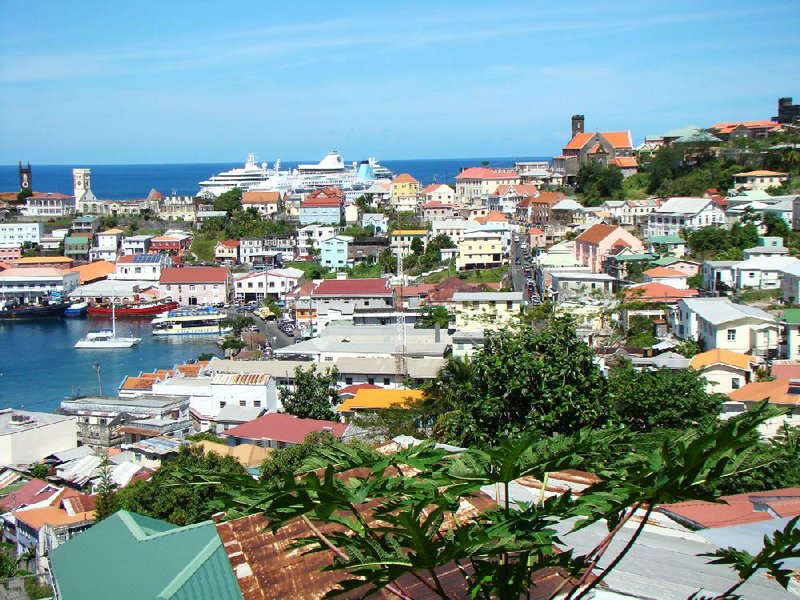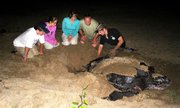ST. GEORGE'S, Grenada — Descendants of ancient seafarers, they travel thousands of miles to reach their destination - an isolated beach where the Caribbean meets the Atlantic Ocean at the northern tip of Grenada - the tiny West Indies island nation just north of Venezuela.
The females paddle ashore under cover of darkness, leaving the males behind.
These intrepid travelers - with origins as old as the dinosaurs are the leatherback turtles, the world's largest sea turtles. Named for their relatively soft shells, the giant turtles swim from cooler waters back to their tropical birth beaches, where the females lay eggs in the sun-warmed sand.
Better known as the Spice Island for its nutmeg, cloves and cinnamon, Grenada is far enough off major tourist paths and heavy-duty development for sea turtles to nest as they’ve done since before humans inhabited the earth.
Fortunately for the turtles, they haven’t gotten a lot of publicity. Grenada is better known for uncrowded beaches, yachting regattas and one of the region’s primo diving sites - the Bianca C, the largest shipwreck in the Caribbean.
But for me, the turtles were the unexpected highlight.
Weighing 1,000 pounds and more, with shells often greater than 5 feet in length, the females lay their eggs from April through July. During the nesting season, local guides lead would-be turtle watchers along the night beach single file, with the only illumination coming from the leader’s infrared light.
We were lucky. Our turtle showed up almost immediately. As she used her giant rear flippers to dig a nest, most of our group of a dozen held their cell phones aloft - encircling the turtle like some strange fertility rite - snapping pictures revealing nothing more than an infrared blob.
The experts from the nonprofit Ocean Spirits checked her tag. She’d already been here this year. That was not surprising since leatherbacks return several times during the nesting season to lay eggs. Each time they dig a pit more than 2 feet deep for their eggs. Pit completed, for the next hour, with occasional soft, horse-like whinnies and thrashing of rear flippers, our turtle pushed out 70 soft, round fertilized eggs the size of billiard balls, then another 33 unfertilized, ping-pong-ball size eggs as insulation.
Midway through the egg laying our guide told us, “You can touch her. She’s in a trance.” No need for encouragement or congratulations, the leatherback was carrying out her ancient programming before heading out to sea. Any fledglings to emerge would be on their own.
After the egg-laying, seemingly exhausted, our turtle spent a long time roughing up a large swath of sand, camouflaging her nest. She had no idea that the Ocean Spirits team had caught her eggs as she laid them, transporting them to higher ground, where the tide would be less likely to wash them away. At best, only one in 1,000 fledglings survives to adulthood.
TRIO OF ISLANDS
The most southerly of the Windward Islands, Grenada remains relatively untouched. With a population of about 108,000, the nation includes the main island of Grenada (21-by-12 miles) plus Carriacou and Petite Martinique, small islands to the north.
While turtles head for the isolated northern beach of Levera, in the south, Grand Anse Beach, the two-mile sweep of sand on the Caribbean side of the island, is the major destination for the more sybaritic human. No mega hotels mar the view; no factories foul the air. Buildings can be no taller than a palm tree.
A few luxury resorts and less expensive hotels co-exist along the beach, which is open to all.
A bus network of small, communal vans crisscrosses the island from the terminal in St. George’s, the capital. Jammed in with locals, this may be the surest way for a visitor to get close to Grenadians. But with the hilly terrain, those subject to carsickness should try to sit up front.
During a tour of Laura Herb and Spice Garden, a botanical showcase rich with the scent of cinnamon and allspice, one visitor was felled by carsickness. In a heap on the ground, she remained too dizzy to move. The remedy was fresh ginger root from the garden. A few nibbles of ginger, cleaned of its outer covering, cured her. By afternoon she was drinking margaritas.
Not just a one-cure garden shaded by cocoa, nutmeg and cinnamon trees, Laura’s is a pharmacopeia of natural remedies. It offers cures for insect bites, diarrhea, asthma, menstrual cramps and even cancer.
With ginger at the ready, the curving roads are well worth the trip over the mountainous spine of the island formed by prehistoric volcanoes. For hikers, Grenada’s national parks offer much more rugged terrain in cloud capped rain forests.
Along the road, brightly painted concrete bus shelters advertise local products, including Nut-Med, the instant pain reliever with nutmeg oil. Pink, blue and orange houses with red roofs line the road.Painted tires hold blossoming plants. A goat with bushy brown goatee is tethered roadside. A white-chested mona monkey appears in a roadside tree. And everywhere, the nonstop chirping of tree frogs fills the air.
MARKET SQUARE
When it comes to food, the leatherback turtles feed almost exclusively on jellyfish. But for humans, Grenada’s agricultural and fishing economy offers abundant choice. St. George’s small, open-air street market on Market Square showcases the bounty. At its peak on Saturdays, vendors display bananas still hanging in giant clusters, mangoes, coconuts,ginger, hot peppers and root vegetables. In a nearby building, women sell small bags of nutmeg, balls of chocolate to grate for hot chocolate and gift baskets of spices.
The ocean yields a rich supply of fish. The biggest fish feast of all occurs on Fish Friday, the weekly evening event in Gouyave, a fishing village on the west coast. Started after Hurricane Ivan decimated Grenada in 2004, Fish Friday is now a Grenada institution. Vendors line the streets grilling, steaming and sauteeing the fresh catch as locals and visitors make the rounds, usually accompanied by music.
You can do your own cooking of local specialties with lessons from the chefs at Aquarium, one of Grenada’s top restaurants. I joined a class that made pumpkin and ginger soup and callaloo cannelloni, using the leafy green callaloo that tastes a bit like spinach. We cooked in the kitchen of one of the luxury tourist suites at Maca Bana (owned by the same couple who own Aquarium), then ate our meal on a patio overlooking the Caribbean.
It’s possible to eat, drink and swim without ever going into St. George’s, but the tiny capital explodes with activity. Cars honk hellos. Giant speakers in front of hole-in the-wall bars blare soca (as in “soul of calypso”) and steel pan music. Students at the New Dimension School Steel Band Music Program fill the surrounding streets with the sounds of heaven or pandemonium, depending on your taste. In the fish market by the town dock, fishmongers scream at each other, oblivious to the sign requesting “No obscene language.”
But night by the beach in Grand Anse brings almost total quiet. As little puffs of tropical air blow in from the Caribbean, the only sounds are the surf breaking along the sand and the tree frogs. And in the north, where the leatherbacks come ashore, an even deeper quiet envelops this still natural island.
Ways and means
IF YOU GO
There are direct flights from Miami on American Airlines three times a week. The best prices are offered in the off-season. Watch for deals.
TURTLE WATCHING
No guarantees but odds are good you’ll witness a leatherback laying her eggs on the beach during the nesting season, April through July. Local and international organizations are working together to protect Grenada’s leatherback turtles. Guides are trained by the St. Patrick’s Eco-Conservation Tourism Organization (SPECTO) in coordination with Ocean Spirits (oceanspirits.org). Ocean Spirits, which works with the Grenada government, is the local arm of the Wider Caribbean Sea Turtle Conservation Network (widecast.org).
Tour operator Mandoo is one of several guides working with Ocean Spirits (grenadatours.com/turtlewatch.php). Roundtrip transportation from hotels in the Grand Anse area to Levera Beach is about a 90-minute ride, where participants are met by a guide. Hotel pickup is at 6 p.m. Return is at midnight. Price: $60, includes a $10 contribution to Ocean Spirits.
GRENADIAN HISTORY
This small island has packed in a lot of history. In the 1520s the Spanish called it Granada (Gra-NAH-da), after its namesake in Spain. The British later anglicized it to Grenada (Gre-NAY-da). Starting in the 1600s French and British struggled for dominance and brought in West African slaves to work sugar cane plantations. (Check out River Antoine Rum Distillery, turning sugar cane into alcohol with methods unchanged since the 18th century.) Now nutmeg is Grenada’s major export, followed by cocoa beans.
Independence from Britain came in 1974 but Commonwealth membership couldn’t save Grenada from the 1983 U.S.-led “incursion,” as it’s politely known. The landing was triggered by Cuban involvement in Grenada and political rivals’ execution of Prime Minister Maurice Bishop, head of the People’s Revolutionary Government. Today things are calm and Grenadians would probably welcome a tourist invasion.
This is hardly a patch of England, but expect British street names, children in school uniforms, cars driving on the left and a passion for cricket.
For more information, visit grenadagrenadines.com.
- Amy Stone
Travel, Pages 50 on 07/29/2012

